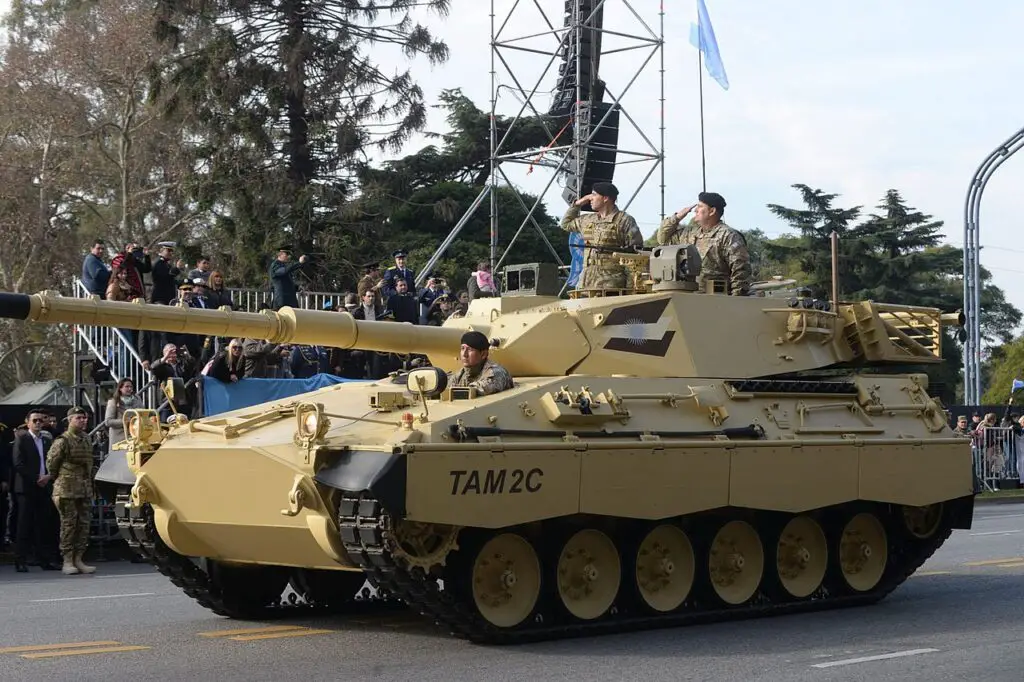The Ministry of Defense and the Argentine Army have signed an agreement with the company Industrias Mecánicas Pescarmona SA (IMPSA) for the manufacture and modernization of towers within the framework of the modernization project for the Argentine Medium Tank TAM 2C (30.5 ton Tanque Argentino Mediano), the mainstay and most powerful vehicle armoured vehicle in the country.
The contract includes welding services for the supports of the auxiliary power unit and the equipment-carrying bracket of the tower. Work is being carried out at the Arsenals Battalion 602. Argentina plans to ready two to three TAM-2S tanks by the end of the year.
The initiative has contributions from the National Defense Fund (FONDEF). IMPSA is a local company specializing in high metallurgy and energy generation with clients worldwide.
TAM 2C Project
The TAM 2C project aims to update this combat vehicle with all the technological advances that allow it to fulfil its mission in the most diverse situations it may face. It involves local labour, training of participating personnel and technology transfer.
TAM 2C upgrades will enable TAM an increased chance of survival, the ability to respond to threats, and the possibility of fighting both during the day and at night.

It was also sought to improve the level of protection of the crew; optimize static and moving shooting accuracy; prioritize the digitization of the control and firing systems, and eliminate the old hydraulic systems for the movement of the tower. For this, it was necessary to form a work team of military engineering officers and General Staff, technical non-commissioned officers of various specialities and Cavalry, and trained civilian personnel. Among the main modifications is a new electronic system for movement of the tower and a new digital system for control and execution of the shot.
TAM 2C allows the tank to fire three shots rapidly because, going at full speed and in stabilized mode, the tank moves according to the terrain while the gun remains practically immobile, pointing at the chosen target. Once a manual loader loads the gun, it gets stabilized, automatically aligns itself and stabilizes with the line of sight. The time gained allows three shots to be fired from the tank. It is estimated that with special ammunition, it can have an effective range of 3,500 m, equating to higher calibre opponents. The special ammunition includes APFSDS shells, a new HEAT shell and the capability to fire LAHAT anti-tank guided missiles.
With this goal in mind, in 2010, Argentina agreed with a consortium formed by Israel Military Industries (IMI) and the Elbit and Tadiran to adapt these tanks to the 2C version. It integrates electronic devices of Israeli origin, such as new sights with video cameras, infrared sensors, or a system to track targets at 360 degrees.
In the agreement, which was the basis of the subsequent agreement for the modernization of the TAM to its TAM 2C version, the development and evaluation of a prototype were agreed to then continue with the serial production of TAM combat vehicles with Army personnel. The first prototype construction was launched in 2013. In 2014, the prototype was completed and approved, and a new agreement was signed for the modernization of 74 TAM combat vehicles to the TAM 2C version. Subsequently, the project was stalled.
The TAM 2C project today
In early 2021, Argentina and Israel agreed to resume the TAM modernization project, according to statements by the former Argentine ambassador to Israel, Sergio Urribarri.
After a meeting with the director of the International Cooperation Agency of the Israeli Ministry of Defense, Brigadier General Yair Kulas, the Argentine diplomat, explained that the work would begin that same year and last for the next 5 to 7 years.
Likewise, the ambassador highlighted that the Israeli government assured him that the TAMs would be equipped with modern technology developed during the years that this project was on hold, without this implying an increase in the value of the original contract.
The Argentine Medium Tank
The TAM family is the flagship armoured and mechanized element of the Army. All TAMs were produced between the late 1970s and early 1990s when it was decided to modernize the ageing Sherman tank fleet. The government at that time was clear about the type of vehicle it needed and gave instructions to the then-German Thyssen-Henschel consortium for its development and the production of prototypes. Other than TAM, the German company’s products included Sedena-Henschel HWK-11 – infantry fighting vehicle for the Mexican Army, TM-170 APC, Marder infantry fighting vehicle and Sri Lanka Railways M6.
The firm was also in charge of training the engineers and transferring the necessary technology so that they could be carried out in the country, something that was achieved in 1980 after the Tamse company (Tanque Argentino Mediano Sociedad del Estado) was established. The variations that are operational today are the VCPC (Command Post Combat Vehicle), the VCTM (mortar carrier/mine sweeper), the VCTP (infantry combat vehicle), the VCA (Artillery Combat Vehicle), the VC AMUN (to resupply artillery vehicles), the VCCDT (Combat Vehicle Fire Direction Center) and the VCLC (with LAR-160 multiple rocket launcher).
TAM is easy to maintain, has a good radius of action – 590 km (370 mi), excellent mobility and a powerful 105 mm cannon, which is extremely dangerous with adequate ammunition. The Rheinmetall’s Rh-105-30 105 mm (4.13-inch) gun for the tank is manufactured in Argentina under the designation FM K.4 Modelo 1L.
For Argentina, the TAM is a worthy medium-armoured vehicle with an important logistical, training and industrial level developed by the Argentine Army (EA), achieving an interesting operational readiness rate in armoured squadrons. Adapted and tested for the practical realities of the country, the system kept the armoured component in the forefront but required modernization in keeping with the times.
